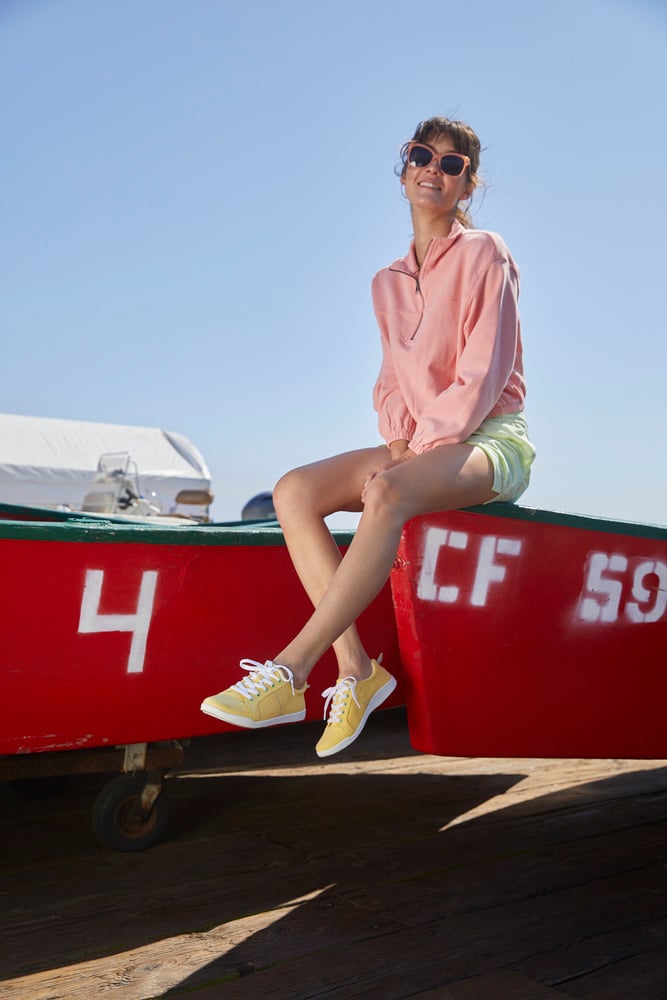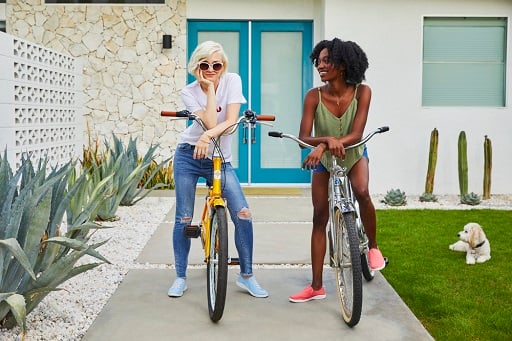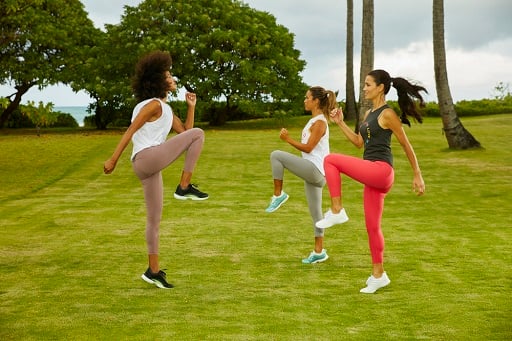
It’s indisputable that having the right tools for the job matters. After all, you wouldn’t ride a donkey in the Kentucky Derby, and you wouldn’t repair a car engine with a spatula.
So why are you working out in the wrong shoes? Finding sneakers for working out or walking shoes for women doesn’t have to be a chore!
Maybe you bought tennis shoes for walking, or perhaps your workout sneakers seem perfect for a bike ride, but foot strain or ankle pain can spoil your exercise faster than a patch of bad weather. So read on if you’re wondering what the best shoes to workout in are and how to find them.
Sneakers, Tennies, Crosstrainers…What’s in a Name?
What do you call your workout shoes?
- Sneakers
- Tennis shoes
- Trainers
- Athletic shoes
- Gym shoes
Over the years, the options available from the shoe and sneaker industry have expanded immensely and all of these terms have muddled together. However, each of these shoe types actually has a distinct meaning and purpose.
The term “sneakers” can be traced back to the late 1800s when English schoolchildren referred to their newly patented canvas-topped, rubber-soled court shoes as sneakers because they were quieter than the leather-soled shoes previously worn to play tennis.1 Also known as plimsolls (in reference to their similarity with sailing boats of that name) or tackkies, by the beginning of the 1900’s, this style of shoe was in huge demand in both England and the United States. The 1936 Olympics brought sneakers onto the international athletic stage, and they’ve only increased in popularity, variety, and availability since.2
From their humble beginnings as canvas and rubber schoolboy sneakers, athletic shoes have morphed into a myriad of shapes and styles for everyone today.
Basics of Workout Shoes
The shelves of athletic shoes at any sporting goods store can be an overwhelming place. Finding the right shoe can seem difficult. There’s high-tops and low-tops, neon-hued canvas against shiny leather or nubby wool, and prices ranging from the modest to the astronomical. Choosing among them can be daunting. But that’s where a little planning and knowledge will serve you well in choosing the best workout shoes.
Anatomy of a Shoe
Before moving into which shoe is best to workout in, take a moment to get familiar with some of the common terminology for the different parts of a shoe.
The Upper
Every part of the shoe above the sole, including:
- Vamp – The front of the shoe
- Quarters – The sides and back of the shoe
- Toe – The tip at the front of the shoe, usually made of durable leather or rubber for added reinforcement
- Collar – Edge around where you insert your foot, often padded for comfort
- Counter – Back of the shoe material that helps stabilize the heel area
The Inner
Everything inside the shoe, including:
- Lining – Soft and absorbent inner material
- Tongue – Flexible material beneath the laces
- Heel cup – The reinforced area around and under the heel
- Arch – raised support in the mid-medial region
- Insole – Cushioned lining within the shoe
The Sole
Every part of the shoe below the upper, including:
- Midsole – layer of material that provides support between outsole and insole
- Outsole – Hardest material on the bottom of the shoe
- Heel – Attached to the sole of the shoe to help raise and support it
- Tread – The pattern of ridges and grooves on the bottom of the sole
Most Popular Types of Workout Shoes
By far, the most important consideration in choosing the best shoe for working out is how you will be using it.
- Are you a walker or a runner? How many miles each week and on what terrain? Do you mostly focus on cardio workouts?
- Do you use your shoes to pedal a bike or take indoor cycle classes?
- Do you lift weights?
- Do you play a court sport like tennis, squash, or basketball?
- Do you enjoy trying different sports?
- Are you engaged in a niche sport that requires specialized footwear?
The way you move your feet for weight lifting is inherently different than how you’d move them in a game of tennis. Identify your workout routine, then find the best gym shoe for you. That’s how you plan to use your feet should determine the kind of shoes you buy for them.
Walking Shoes
Among Americans who do exercise regularly, walking is by far the most popular activity with 30% of the market share.3 But despite the exercise’s popularity, finding the right walking shoe takes a little research. While many shoes bill themselves as walking shoes, only a quality one will prevent common walking ailments like blisters, shin splints, and plantar fasciitis. Slip on sneakers can be a great solution for walking shoes.
Make sure that the shoe you choose has the following attributes:
- Ample arch support
- Deep heel cups
- Firm but flexible insole
- Weatherproof midsole and outsole
Weight lifting Shoes
Second in popularity to walking, weight lifting is an important part of a well-rounded exercise routine. Building and maintaining strength is essential for good health but requires the correct supportive shoes. Good quality weightlifting shoes will be built entirely differently than walking shoes. They should have significantly less padding in the inner, but a higher heel, and very grippy soles.

Running Shoes
Like walking shoes, a running shoe should be flexible, slightly rounded, well-padded, and strongly support the heel and arch areas. However, running shoes should have additional support in the ball of the foot for additional impact absorption. Tennis shoes are often synonymous with running shoes when talking about them in an everyday conversation. Learn about the differences of tennis shoes vs running shoes right here at Vionic.
If you intend to run in rough terrain or on trails, consider a trail runner which is less flexible but has a knobby sole for grip in slippery conditions.
Cross Training Shoes
Maybe you like to take a walk and then finish up with some free-weights. Or you jog on the treadmill and then use the weight machines at your gym. However you combine your aerobic workout with your strength workout, you need an athletic shoe that can support both activities. This is a job for a crosstrainer! A cross training shoe is a versatile shoe that combines the support and flexibility of a walking shoe with the grippiness and stability of a weightlifting shoe.
Tennis Shoes
Although many people refer to their exercise shoes as tennis shoes, these are actually a very specific type of court shoe meant for providing lateral support during the explosive side-to-side movement needed for a game of tennis. Unless you are truly using them to play tennis, this shoe is not meant for a casual exerciser. If you’re looking to find the best tennis shoes for standing all day, Vionic is a good place to start.
Basketball Shoes
Clearly different than the other shoes on this list, basketball shoes are carefully designed to provide an extreme level of support for dynamic movement on the court. They usually have a high top for ankle stability, but some can be mid-top or even low-top. This is known as the cut length of the shoe.
No matter the height, though, all basketball shoes feature a stiff, dense sole for support and side ventilation holes.
Niche Sport Shoes
Whatever your sport (besides swimming, of course), there’s a perfect and supportive shoe for you. Niche sports often require specialized shoes. If you are trying a new sport, be sure to do a little research about the proper footwear before you embark.
These are some popular niche sports that require specialized shoes:
- Track
- Rock-climbing
- Football
- Soccer
- Dance
- Cycling
- Bowling
Correctly Fitting Your Workout Shoes
Now that you’ve decided on the type of shoe you need for success in your workout routine, it’s time to understand how to get the right fit. Whether you’re running, weightlifting, cross training, or bowling, a correct fit allows you to access your shoe’s full potential. Here are some tips to making sure your shoe fits correctly:
- Have your feet professionally measured as they can change size with age. Remember to measure not only the length but also the width of your foot.
- If one of your feet is likely larger than the other, fit your shoes to the larger foot.
- Know that you might need a bigger shoe than you think. Exercise will increase the size of our feet as your pumping heart will send more blood to your extremities, so a shoe that fits perfectly when you’re casually shopping might feel constricting when you’re hitting your favorite running trail. For an accurate sizing, measure your feet at the end of the day when they are at their most swollen.
- Never buy shoes that feel slightly tight. You can’t be sure that they will stretch.
- Make sure the shape of the toe-box fits you, especially if you have long or wide toes.
- Always stand and walk around in the shoes. This is the best way to gauge fit.
What to Do Once You’ve Got the Right Shoes
It can seem a small triumph to finally choose the best fitting shoes for your workout. To set yourself and your shoes up for ultimate success don’t forget to start slow and use proper form. Even the best shoes take a little time to settle around your feet. However, stop exercising immediately if you feel pain or have a nagging ache in your feet after starting a workout. Some signs that your shoes are quite right might be blisters, aching arch or toes, or leg fatigue.
If you’re not looking for sneakers for working out and instead want to find the most comfortable fashion sneakers, we have some suggestions!

Work Out With Vionic
At Vionic, we pride ourselves in crafting comfortable, stylish, and supportive footwear for your workout. From our classic walkers to our old-school trainers, we have men’s and women’s athletic shoes that fit your goals. Or, if you’re looking for an everyday shoe, we have you covered. (Wondering what lifestyle shoes are? We can answer that too.) We recommend wearing your new shoes for only a few hours for the first few days to allow your feet to adjust to the new level of orthotic support and comfort. Within one to two weeks you should be finding them completely supportive and comfortable.
Sources:
- “Sneaker.”. Etymoline. https://www.etymonline.com/word/sneaker
- “The History of the Sneaker.” The Washington Post. https://www.washingtonpost.com/archive/lifestyle/2002/05/14/the-history-of-the-sneaker/aa2096d1-a7e2-4427-a324-cb603512722d/
- “Sports and Exercise.” US Bureau of Labor Statistics. https://www.bls.gov/spotlight/2008/sports/
- “Fast Stats: Exercise or Physical Activity.” Centers for Disease Control and Prevention. https://www.cdc.gov/nchs/fastats/exercise.htm


Leave a Reply